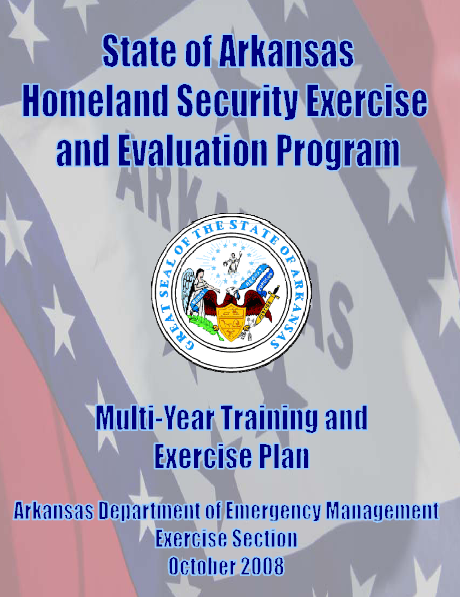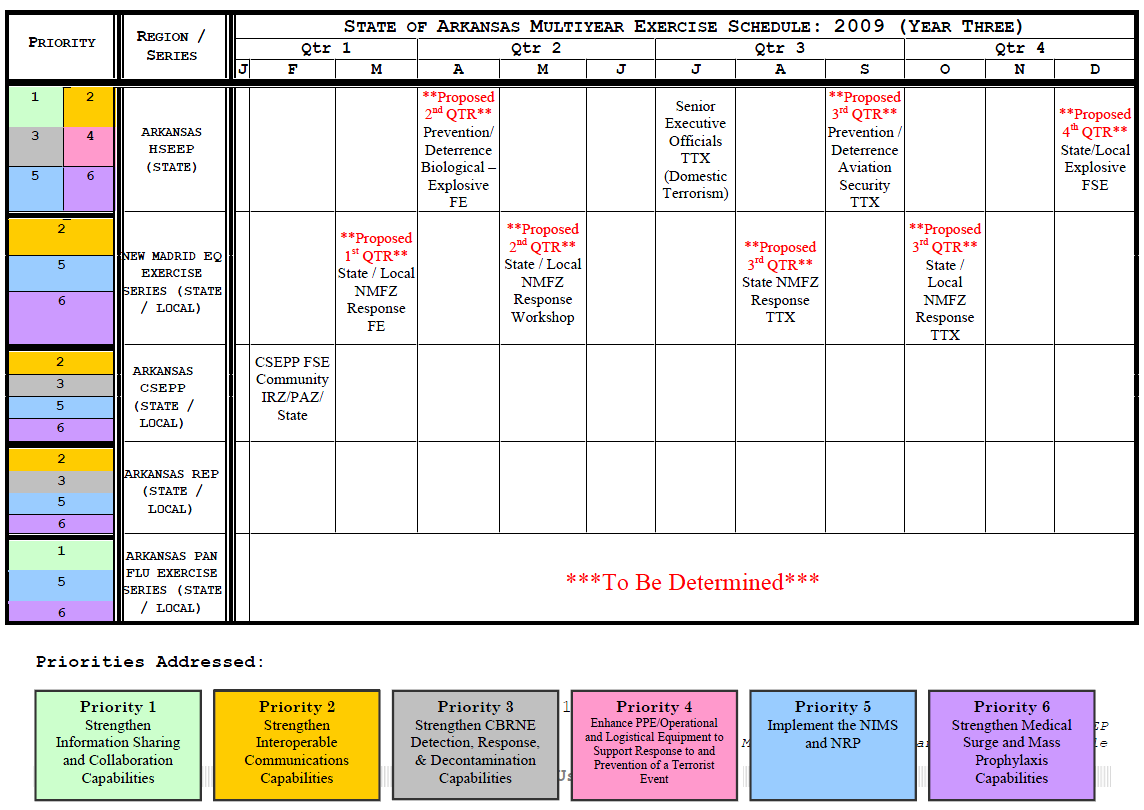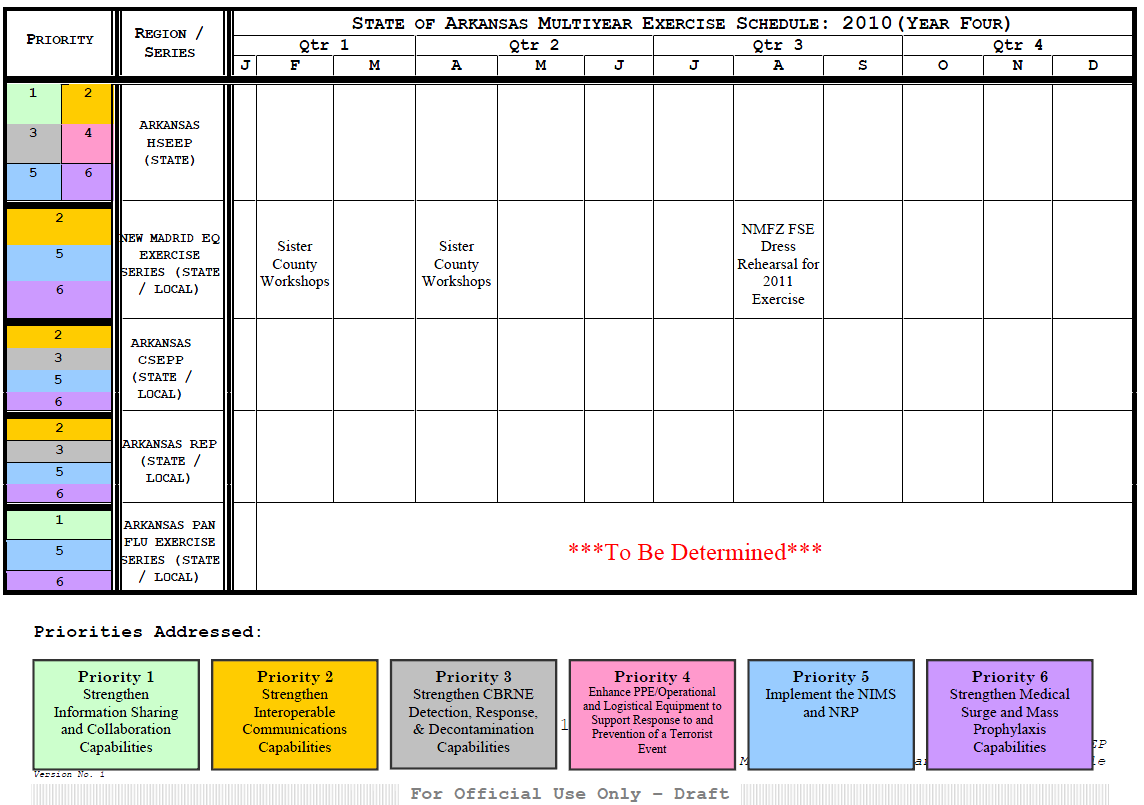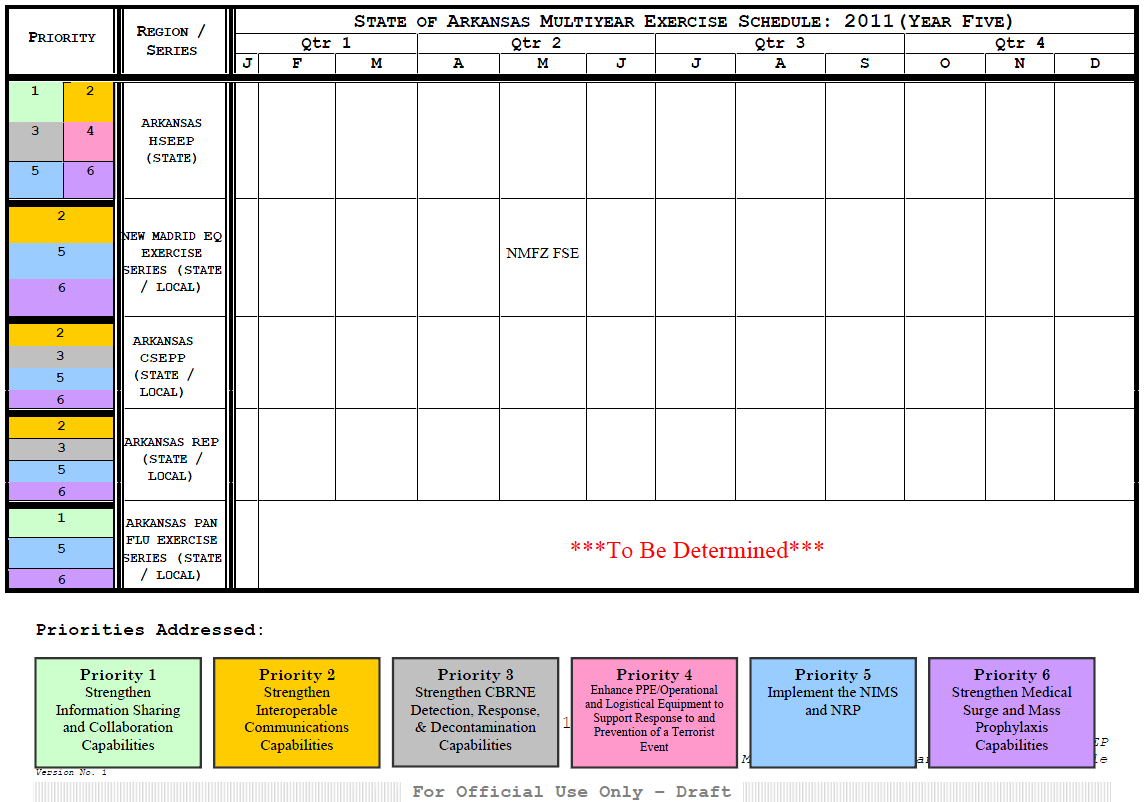 Arkansas Homeland Security and Preparedness Agency
Arkansas Homeland Security and Preparedness Agency
- 21 pages
- Draft
- For Official Use Only
- October 2008
PURPOSE
State of Arkansas
The purpose of the Multiyear Training and Exercise Plan (TEP) is to provide a follow-on companion document to the Arkansas Homeland Security Strategy. It is a living document that will be updated and refined annually. The Multiyear TEP provides a roadmap for Arkansas to follow in accomplishing the priorities described in the Homeland Security Strategy. Each priority is linked to a corresponding National Priority, and, if applicable, an
Improvement Plan (IP) action. The priority is further linked to the associated target capabilities that would facilitate accomplishment of the priority and the training and exercises that will help the jurisdiction obtain those capabilities and achieve that priority. Included in the Multiyear TEP is the training and exercise schedule, which provides graphic illustration of the proposed activities, scheduled for the years 2007-2011. It is representative of the natural progression of training and exercises that should take place in accordance with the building-block approach.The Arkansas Department of Emergency Management is committed to the ongoing
improvement of the all-hazards emergency response and preparedness posture of the State of
Arkansas. This commitment has been and continues to be displayed through the
implementation of progressive and comprehensive training and exercise initiatives in
accordance with state and federal requirements. A crucial component of these initiatives is
the implementation of the Arkansas Homeland Security Exercise and Evaluation Program
and the State Multi-Year Training and Exercise Plan. The implementation of these
components is a reflection of our dedication to the safety and well being of the people of
Arkansas as stated in the Arkansas State Homeland Security Strategy.The intent of the plan is to forecast State Training and Exercise activities to ensure that the
preparedness posture of the State is increased and maintained as well as benchmarking the
implementation of leveraged Homeland Security funds awarded to the State of Arkansas and
its 77 local jurisdictions.…
PROGRAM PRIORITIES
State of Arkansas
The following priorities were identified by the Arkansas Homeland Security Advisory Group
in accordance with previous grant year priorities. The State of Arkansas strives to improve
the preparedness and response posture of local jurisdictions in an all-hazards and capabilities
based manner, while focusing specific statewide and jurisdictional capabilities based
planning, training, and exercising efforts towards known catastrophic threats such as the
New Madrid Seismic Zone and the potential human and agricultural impacts of man-caused
and naturally occurring pandemic/outbreak diseases.1. Strengthen Information Sharing and Collaboration Capabilities: The State of
Arkansas will work to ensure the establishment of a State Fusion Center in order to
enhance the information/intelligence sharing among all necessary entities. The
establishment and implementation of a State Fusion Center will enable the State of
Arkansas to utilize resources available through local, state and federal entities which will
provide information from across the state that can be shared through law enforcement
channels for determination of credible intelligence.2. Strengthen Interoperable Communications Capabilities (AWIN System
Expansion / Enhancement): The State of Arkansas will continue to support the
enhancement of interoperable communication, both at the local and state level. We will
utilize the expertise of the State Chief Information Officer to assist in determining needs
in the area of cyber security and geographic information technology as support elements of
our communication effort to address these initiatives.3. Strengthen CBRNE Detection, Response, & Decontamination Capabilities: The
State of Arkansas will continue to ensure that responders have basic, self-sustaining and
operational/safety equipment and that those with increased capability have advanced
equipment for response to a WMD or CBRNE event. The State of Arkansas will also work
to strengthen the integration of local / regional HazMat and Decon Teams and State
Agricultural Inspection Teams in order to support a galvanized response to and recovery
from potential acts of agricultural terrorism involving a chemical or biological agent.
Ongoing establishment, sustainment, and evaluation of Emergency Ordinance Disposal
teams will continue to be a priority to ensure adequate response to incidents involving
explosive devices.4. Enhance PPE/Operational and Logistical Equipment to Support Response to
and Prevention of a Terrorist Event: The State of Arkansas will continue to support
its jurisdictions and agencies terrorism response and prevention capabilities through
leveraging funds available to purchase items such as site surveillance systems, shelter
systems, SAR ensembles, terrorism prevention software/hardware, tactical entry
equipment (law enforcement), and command vehicles. Agencies/personnel that will
use/implement equipment purchased with leveraged funds will be trained prior to SAA
purchase approval. This equipment will be integrated into state and jurisdiction specific
exercises in order to benchmark and evaluate the efficacy of funds leveraged.5. Implement the NIMS and NRP: The State of Arkansas will continue the phased
implementation of the National Incident Management System and National Response
Framework in accordance with Homeland Security Presidential Directives 5 and 8 and the
respective NIMS Compliance Matrices for States and Territories / Local Jurisdictions as
provided by the NIMS Integration Center. The Command and Management component of
the NIMS will continue to be integrated into all emergency response exercises utilizing the
State Homeland Security Exercise and Evaluation Program and shall focus on the Onsite
Incident Management and/or Emergency Operations Center Management Target
Capabilities.6. Strengthen Medical Surge and Mass Prophylaxis Capabilities: Through
interagency coordination between ADEM and the Arkansas Department of Health and
Human Services, Division of Health (ADHHS-DH), ensure that all funding for medical
surge and mass prophylaxis is utilized to its fullest extent. Multi-agency coordination,
between the Arkansas Homeland Security Advisory Group (ARHSAG) and the Centers for
Disease Control and Prevention / Health Resources and Services (CDC/HRSA)
Administration Advisory Committee, will also be implemented to coordinate
implementation of CDC/HRSA Public Health Preparedness Cooperative Agreement,
CDC/HRSA Bioterrorism Hospital Preparedness Program (BHPP), and Metropolitan
Medical Response System (MMRS) funds. To this end the State of Arkansas shall provide
for necessary equipment required to enhance the ability of medical response personnel, in
the metropolitan area and throughout the state, to respond to a mass casualty event. The
State Homeland Security Exercise and Evaluation Program (SHSEEP) and the Arkansas
Training and Exercise Task Force (AR T&ETF) shall be utilized as the primary tool to
assess and evaluate medical surge, mass care, and mass prophylaxis capabilities.
The State of Arkansas based its priority determination on past events such as 9/11 and the
Oklahoma City Bombing of 1995 (especially given the OKC incident’s geographic and
economic proximity), as well as potential and existing threats to the State and its
jurisdictions. The State of Arkansas recognizes the following Target Capabilities, as
promulgated by the National Preparedness Goal and HSPD’s 5 and 8, as crucial to providing
a coordinated and successful approach to emergency preparedness and response:Priority 1: Prevention Mission Area
Information Gathering and Recognition of Indicators and Warnings
Intelligence Analysis and Production
Intelligence / Information Sharing and DisseminationPriority 2: Common Mission Area
CommunicationsPriority 3: Prevention, Protection, and Response Mission Areas
CBRNE Detection
Food / Agricultural Safety and Defense
Animal Health Emergency Support
WMD / Hazardous Materials Response and Decontamination
Explosive Device Response OperationsPriority 4: Protection and Response Mission Areas
Law Enforcement Investigation and Operations
Fire Fighting Operations and Support
Urban Search and Rescue (Land Based)
Critical Infrastructure ProtectionPriority 5: Common and Response Mission Areas
Communications
EOC Management
Onsite Incident ManagementPriority 6: Response Mission Area
Fatality Management
Mass Care
Mass Prophylaxis
Medical Supplies Management and Distribution
Medical SurgeThese Target Capabilities are the cornerstone of the State of Arkansas’s approach to allhazards emergency and catastrophic disaster preparedness activities at this time and translate directly to the State Homeland Security priorities as identified and defined above.
…



